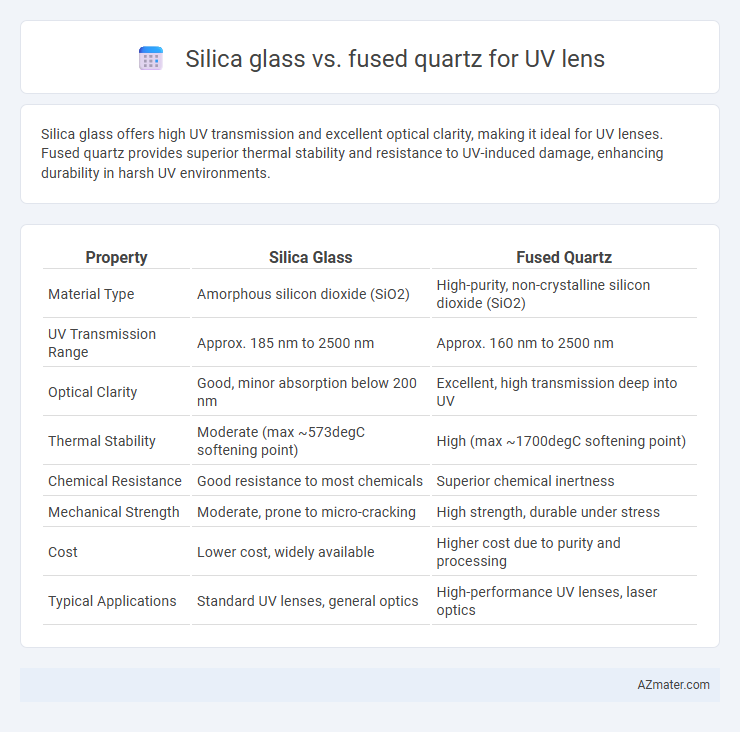Silica glass offers high UV transmission and excellent optical clarity, making it ideal for UV lenses. Fused quartz provides superior thermal stability and resistance to UV-induced damage, enhancing durability in harsh UV environments.
Table of Comparison
| Property | Silica Glass | Fused Quartz |
|---|---|---|
| Material Type | Amorphous silicon dioxide (SiO2) | High-purity, non-crystalline silicon dioxide (SiO2) |
| UV Transmission Range | Approx. 185 nm to 2500 nm | Approx. 160 nm to 2500 nm |
| Optical Clarity | Good, minor absorption below 200 nm | Excellent, high transmission deep into UV |
| Thermal Stability | Moderate (max ~573degC softening point) | High (max ~1700degC softening point) |
| Chemical Resistance | Good resistance to most chemicals | Superior chemical inertness |
| Mechanical Strength | Moderate, prone to micro-cracking | High strength, durable under stress |
| Cost | Lower cost, widely available | Higher cost due to purity and processing |
| Typical Applications | Standard UV lenses, general optics | High-performance UV lenses, laser optics |
Introduction to UV Lenses: Silica Glass vs Fused Quartz
Silica glass and fused quartz are essential materials in UV lenses due to their high optical clarity and excellent transmission in the ultraviolet spectrum, typically ranging from 190 to 350 nanometers. Fused quartz, known for its superior purity and low impurities, offers higher thermal stability and resistance to UV-induced damage compared to standard silica glass. These characteristics make fused quartz the preferred choice for high-precision UV optical applications requiring durability and minimal light absorption.
Composition and Manufacturing Differences
Silica glass primarily consists of silicon dioxide (SiO2) with minor impurities, while fused quartz is nearly pure SiO2 with extremely low levels of impurities, resulting in superior UV transmission. Manufacturing fused quartz involves melting high-purity quartz crystals to form a homogeneous glass, whereas silica glass production may include controlled melting of natural quartz sand with additives. These differences lead to fused quartz exhibiting higher purity, better thermal stability, and enhanced UV transparency, essential for UV lens applications.
Optical Transmission in the UV Spectrum
Silica glass offers superior UV transmission with high transparency down to approximately 180 nm, making it ideal for deep UV optical applications. Fused quartz provides excellent transmission down to around 190 nm but may exhibit slightly higher absorption compared to high-purity silica glass in the lower UV range. The choice between silica glass and fused quartz for UV lenses depends on the specific wavelength requirements and transmission efficiency needed for optimal optical performance.
Durability and Thermal Resistance
Silica glass offers high durability and exceptional thermal resistance, making it suitable for UV lens applications requiring stability under extreme temperature fluctuations. Fused quartz surpasses silica glass in thermal shock resistance due to its low thermal expansion coefficient, enhancing lens longevity during rapid heating or cooling cycles. Both materials provide excellent UV transparency, but fused quartz is preferred when enhanced durability and superior thermal stability are critical for performance.
Cost and Availability Comparison
Silica glass generally offers lower cost and higher availability compared to fused quartz, making it a more economical choice for UV lens applications. Fused quartz, while more expensive due to its higher purity and superior UV transmission properties, is less readily available and typically used in specialized, high-performance optical systems. The cost difference arises from manufacturing complexity and raw material refinement, with fused quartz demanding more precise and energy-intensive processing.
Purity and Material Consistency
Silica glass offers high purity levels with minimal impurities, ensuring excellent UV transmission and resistance to solarization, making it ideal for UV lens applications. Fused quartz, known for its superior material consistency and homogeneity, provides uniform optical properties and enhanced durability under intense UV exposure. Both materials excel in purity, but fused quartz's manufacturing process results in more consistent performance in precision UV optics.
Applications in UV Optical Systems
Silica glass offers excellent UV transmission with high purity and homogeneity, making it suitable for UV laser optics and photolithography lenses. Fused quartz provides superior thermal stability and resistance to UV-induced damage, essential for high-power UV laser systems and precision UV spectroscopy. Both materials are critical in UV optical systems, with fused quartz favored for demanding environments and silica glass preferred for cost-effective, moderate-power applications.
Handling and Fabrication Considerations
Silica glass offers superior mechanical strength and ease of machining compared to fused quartz, making it more suitable for complex UV lens shapes requiring precise fabrication. Fused quartz, while more chemically pure and thermally stable, demands specialized handling techniques to prevent micro-cracks during cutting and polishing due to its brittle nature. Both materials require careful control of surface quality to maximize UV transmission and minimize scattering in lens applications.
Environmental and Chemical Resistance
Silica glass offers excellent chemical resistance and can withstand harsh environmental conditions, making it highly suitable for UV lens applications exposed to corrosive substances. Fused quartz surpasses silica glass in durability against thermal shock and maintains superior resistance to ultraviolet radiation degradation. Both materials exhibit low thermal expansion and high purity, but fused quartz demonstrates enhanced longevity in aggressive chemical environments and extreme temperature fluctuations.
Choosing the Right Material for UV Lens Applications
Fused quartz offers superior UV transmission down to 180 nm, making it ideal for deep UV lens applications, while silica glass typically transmits UV light above 200 nm and is more cost-effective for standard UV ranges. The thermal stability of fused quartz allows for better resistance to laser-induced damage, crucial for high-power UV laser systems. Selecting fused quartz or silica glass depends on the required wavelength range, laser power handling, and budget constraints in UV optical design.

Infographic: Silica glass vs Fused quartz for UV lens
 azmater.com
azmater.com